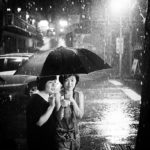Eric Kim is an international street photographer based in Los Angeles. He has traveled the world and shot in cities such as Paris, London, Venice, Florence, Prague and has even taught a street photography workshop in Beirut, Lebanon. He is a lover of black and white, and creates beautiful juxtapositions in his images. Not only that, but he is an anchor in the street photography community through his online presence. You will soon start seeing more content from Asia here as Eric will be connecting us with photographers in the region. Read this interview with him below to get deeper into his head and hear his thoughts about his technique and work.
Q: Out of all the hundreds of different types of photography, why street photography?
A: I feel that out of all the types of photography out there, street photography is the most pure due to the two reasons: you capture candid moments of everyday life while showcasing the human condition. In street photography, it is less about the image but more about the story behind it. An effective street photograph will be able to immerse the viewer in a world of awe and wonder, and place them in your shoes. No other genre of photography does that.
Q: How did you get over the initial fears of approaching people and shooting them?
A: I recall the first time I shot a street photograph of a stranger when I was waiting at a bus stop. A man was reading a book while reclining on a pole, and I was fascinated by how focused yet casual he was. I had this burning desire to capture the image, yet wasn’t quite sure how to approach him. I ended up simply walking closely to him, slowly bringing up my camera to my eye, and clicked the shutter. However the moment I took the photograph, he stopped and looked straight at me from the corner of my eye. My body filled with adrenaline and I couldn’t contain my excitement. I looked into the LCD screen and I nabbed the perfect shot.
Q: Describe your favorite moment of interaction with your subject.
A: Whenever I am taking street photographs, I love it when my subjects make eye-to-eye contact with me. Although it is a bit unnerving at times, I love the human connection that I am able to make with my subjects. As they say, “the eyes are the windows to your soul.”
Q: Within all your travels, where was your favorite place for street photography?
A: Although I have shot all around the world for street photography including Los Angeles, Paris, London, Florence, Venice, and Prague I would have to say that I loved to shoot street photography in Korea by far. Korea is truly the street photographer’s dream paradise, as there are always a plethora of people on the streets and subways constantly interacting. When in Seoul, there was never a moment in which I didn’t move a few steps without having a photo-opportunity. Being Korean, I also cherished the opportunity to get closer to my people (literally).
Q: How do you challenge yourself to improve on your photography?
A: Having shot street photography for many years now, the bar that I set for myself is incredibly high. This means that out of an entire day of shooting on the streets, I would be lucky if I got even one “keeper”. Recently I have challenged myself to shoot street photography with entirely film on my old World War 2-era Contax IIIa rangefinder which was inherited from my grandfather. Although I started street photography with digital cameras, there is something truly magical about shooting with a film rangefinder. You feel more attuned to the environment, the lighting, and the people. Also with the 50mm 1.5 Carl Zeiss Sonnar lens I have tried to take street portraits of my subjects really close.
Q: Describe your photography community.
A: When it comes to street photography, I am more interested in helping out the community than anything else. Over on my blog, I constantly engage my audience about tips, technique, and inspiration when it comes to street photography. I also have been featuring talented up-and-coming street photographers who don’t have that much coverage. My dream is for aspiring street photographers to have a home to interact with others who have this same passion for street photography.
Q: What are your plans with street photography and where do you plan on traveling to next?
A: My ultimate goal with street photography is being able to travel the world and teach it as well. I have a few workshops lined-up this month and I am quite excited.
-Leica Internet Team
To see more of Eric Kim’s work, please check out his street photography blog, or connect with him on Facebook, Twitter and Flickr. You can find out more about his upcoming workshops: in Brighton, UK on May 21 and another in Switzerland on May 22.

Comments (11)